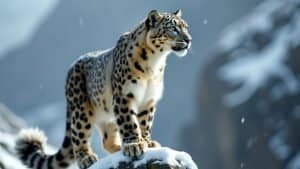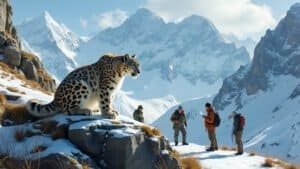Introduction
The World Wildlife Fund (WWF) is dedicated to the conservation of snow leopards, a species that faces significant threats due to habitat loss, poaching, and climate change
This article will explore the various goals and strategies WWF employs in its snow leopard conservation projects. From protecting critical habitats and implementing anti-poaching measures to engaging local communities and advancing scientific research, WWF’s multifaceted approach aims to ensure the long-term survival of this iconic species
Read on to discover how these efforts contribute to broader biodiversity conservation and what future plans are in place to protect snow leopards
Protecting Snow Leopard Habitats
Snow leopards inhabit some of the most rugged and remote mountain ranges in Central and South Asia, where they rely on vast, undisturbed territories to survive
However, these habitats are increasingly under threat due to human activities like mining, infrastructure development, and livestock grazing. Protecting these habitats is a central goal of the World Wildlife Fund’s (WWF) conservation projects, as maintaining intact ecosystems is crucial for the survival of this elusive big cat
Identifying Critical Habitats
One of WWF’s primary strategies is identifying and mapping critical habitats for snow leopards. By using advanced technology such as satellite imagery and Geographic Information Systems (GIS), WWF is able to pinpoint the most vital areas for conservation
These include breeding grounds, migration corridors, and regions with high prey availability. WWF collaborates with local governments and other organizations to ensure that these key habitats are recognized as protected areas, thereby reducing the risk of habitat fragmentation and degradation
In regions like the Altai-Sayan and the Eastern Himalayas, WWF has successfully established large protected areas and conservation zones that provide safe havens for snow leopards
These efforts are bolstered by ground-level research, where camera traps and field surveys conducted by local conservation teams provide data on snow leopard populations and their movements. This information is critical for adjusting conservation strategies and ensuring that protected areas are effectively managed
Preserving Ecosystems and Corridors
Snow leopards are wide-ranging animals, and their survival depends on the connectivity of their habitats
WWF focuses on preserving not just isolated pockets of land but entire ecosystems and migration corridors that allow snow leopards to move freely across their range. These corridors are essential for genetic diversity, which helps maintain healthy populations
To achieve this, WWF works with governments and local communities to implement land-use planning that minimizes habitat fragmentation. For example, in the mountains of Mongolia and Kyrgyzstan, WWF has collaborated with authorities to integrate snow leopard conservation into national land-use policies
This includes designating wildlife corridors and buffer zones around protected areas where human activities are regulated to minimize their impact on snow leopard habitats
Additionally, WWF promotes the restoration of degraded habitats through reforestation and the rehabilitation of grasslands, which are crucial for supporting the prey species that snow leopards depend on. This habitat restoration not only benefits snow leopards but also supports the livelihoods of local communities by improving the health of the ecosystems they rely on
Managing Human-Wildlife Conflict
Human-wildlife conflict is a significant challenge in snow leopard conservation, as snow leopards sometimes prey on livestock, leading to retaliatory killings by herders. WWF addresses this issue by implementing conflict management strategies that reduce the risks to both snow leopards and local communities
One approach is the promotion of predator-proof corrals, which help protect livestock from snow leopard attacks. WWF also supports the use of traditional herding practices, such as night-time corralling and the employment of guard dogs, to deter snow leopards from approaching livestock. These measures have proven effective in reducing livestock losses, thereby decreasing the likelihood of retaliatory killings
Moreover, WWF engages with local communities to raise awareness about the importance of snow leopards and to foster a sense of stewardship
Compensation schemes are also introduced, where herders are reimbursed for livestock losses caused by snow leopards, reducing the economic burden on families and encouraging coexistence with these predators
WWF’s efforts in protecting snow leopard habitats are comprehensive and multi-faceted, addressing the direct and indirect threats to their survival. By focusing on critical habitats, preserving ecosystem connectivity, and managing human-wildlife conflict, WWF is working to secure a future for snow leopards in their natural environments
Implementing Anti-Poaching Strategies
Poaching is one of the most significant threats to snow leopards, driven by the illegal wildlife trade and the demand for their fur and bones. The World Wildlife Fund (WWF) is at the forefront of efforts to combat poaching and protect snow leopards from this grave danger
Through a combination of community-based monitoring, law enforcement, and demand reduction strategies, WWF’s anti-poaching initiatives are vital to ensuring the survival of snow leopards in the wild
Community-Based Monitoring
WWF recognizes that local communities play a crucial role in the fight against poaching. By involving these communities in monitoring efforts, WWF not only empowers local people but also creates a network of vigilant protectors who can detect and deter illegal activities
Community-based monitoring programs train local residents to use tools such as camera traps, GPS devices, and mobile apps to report signs of poaching or the presence of snow leopards
In regions like the Himalayas and the Altai Mountains, WWF has successfully implemented programs where local communities, often referred to as “citizen scientists,” participate in tracking snow leopards and monitoring their habitats
These efforts not only contribute valuable data to conservation projects but also foster a sense of ownership and responsibility among local people, making them active participants in snow leopard conservation
Moreover, these community programs are often linked to incentives, where villagers receive rewards for reporting poaching incidents or for helping to capture poachers. By aligning the interests of the community with the conservation goals, WWF ensures that local people see the preservation of snow leopards as beneficial to their own well-being
Law Enforcement and Patrols
Strengthening law enforcement is another critical component of WWF’s anti-poaching strategy. WWF collaborates with local and national authorities to bolster the capacity of law enforcement agencies to combat wildlife crime
This includes providing training for rangers and wildlife wardens on anti-poaching techniques, intelligence gathering, and the use of technology such as drones and GPS tracking to monitor vast and remote areas where snow leopards roam
In countries like Kyrgyzstan and Nepal, WWF has supported the establishment of specialized anti-poaching units that conduct regular patrols in snow leopard habitats. These units are equipped with the latest technology and work closely with local communities to ensure rapid response to poaching incidents. The presence of these patrols acts as a significant deterrent to poachers, reducing the incidence of illegal hunting and trapping
WWF also advocates for stronger wildlife protection laws and harsher penalties for poachers. By working with governments to draft and enforce legislation, WWF aims to create an environment where poaching is not only risky but also highly unprofitable. This legal framework is essential for long-term success in reducing poaching and protecting snow leopards
Reducing Demand for Illegal Wildlife Products
A key aspect of WWF’s strategy to combat poaching is reducing the demand for illegal wildlife products, which is the driving force behind poaching activities. Snow leopards are targeted for their fur, bones, and other body parts, which are used in traditional medicine, luxury goods, and as trophies
To address this, WWF runs awareness campaigns aimed at curbing the demand for these products, particularly in consumer markets such as China and Southeast Asia
These campaigns focus on educating the public about the impact of the illegal wildlife trade on snow leopard populations and the broader ecological consequences of poaching. By highlighting the cruelty and environmental damage associated with the trade, WWF seeks to shift public perception and reduce consumer demand
In addition to public awareness, WWF collaborates with online platforms, governments, and businesses to crack down on the sale of illegal wildlife products
This includes monitoring online marketplaces, shutting down illegal sales, and promoting the adoption of policies that ban the trade in snow leopard parts. These efforts are crucial in cutting off the financial incentives for poaching, making it a less attractive activity for those involved in the illegal wildlife trade
WWF’s anti-poaching strategies are multifaceted and designed to address the issue from both the supply and demand sides. By engaging communities, strengthening law enforcement, and reducing demand for illegal wildlife products, WWF is making significant strides in protecting snow leopards from the threat of poaching
Engaging Local Communities
The success of snow leopard conservation efforts hinges on the support and active participation of local communities living within and around snow leopard habitats. The World Wildlife Fund (WWF) recognizes this and has made community engagement a cornerstone of its conservation strategy
By involving local people in conservation initiatives, educating them about the importance of snow leopards, and providing sustainable livelihood options, WWF ensures that communities are allies in the fight to protect these endangered big cats
Community Conservation Initiatives
WWF has developed a range of community-based conservation initiatives that empower local populations to take an active role in protecting snow leopards and their habitats. These initiatives often involve the creation of community-managed conservation areas where locals are responsible for monitoring and managing the wildlife within these zones
In countries like Nepal and India, WWF has partnered with local communities to establish community conservation committees that oversee anti-poaching activities, habitat restoration projects, and wildlife monitoring efforts
These committees are made up of community members who are trained in conservation techniques and are provided with the resources needed to protect snow leopards. By placing conservation in the hands of those who live closest to the snow leopards, WWF ensures that local knowledge and expertise are integrated into the protection efforts
Furthermore, WWF supports the development of community-managed ecotourism projects that provide an alternative source of income for local people
These projects, which include wildlife watching tours and homestays, are designed to generate revenue for communities while promoting snow leopard conservation. The income from ecotourism helps fund local conservation initiatives and reduces the dependence of communities on activities that might harm snow leopard habitats, such as overgrazing and deforestation
Education and Awareness Programs
Education is a powerful tool in conservation, and WWF invests heavily in raising awareness about snow leopards among local communities. Through targeted education programs, WWF works to instill a sense of pride and stewardship in the local populations regarding their natural heritage
These programs include school-based education initiatives where WWF provides teachers with curriculum materials focused on snow leopard conservation and broader environmental issues. By educating the younger generation, WWF aims to foster a long-term commitment to conservation within the community
In addition to formal education, WWF organizes workshops, training sessions, and community meetings to discuss the importance of snow leopards and the benefits of conservation
These events often involve interactive activities such as nature walks, storytelling, and cultural performances that connect local traditions with wildlife conservation. By linking the protection of snow leopards to the cultural identity and well-being of the community, WWF ensures that conservation messages resonate deeply with local people
WWF also uses media campaigns to reach a broader audience within snow leopard range countries. These campaigns often feature local voices, including community leaders and respected elders, who speak about the importance of protecting snow leopards. By leveraging local influencers, WWF can more effectively communicate the importance of conservation and inspire action among the broader population
Sustainable Livelihoods for Local People
One of the most effective ways to engage local communities in snow leopard conservation is by providing them with sustainable livelihood options that align with conservation goals. WWF works to develop and promote income-generating activities that reduce the economic pressures on snow leopard habitats and provide direct benefits to local people
For instance, WWF has introduced livestock insurance schemes in areas where snow leopard predation is a concern. These schemes provide financial compensation to herders who lose livestock to snow leopard attacks, reducing the economic impact on families and lowering the likelihood of retaliatory killings. By addressing the economic challenges faced by herders, WWF helps foster coexistence between people and snow leopards
Additionally, WWF promotes alternative livelihoods such as handicraft production, beekeeping, and sustainable agriculture. These activities not only provide income but also help diversify the local economy, reducing the reliance on livestock grazing and other practices that can degrade snow leopard habitats
In many cases, WWF assists communities in finding markets for their products, ensuring that these sustainable enterprises are economically viable
In regions like the Pamirs and the Karakoram, WWF has also supported the development of community-managed pasturelands. These initiatives involve the rotational grazing of livestock, which helps prevent overgrazing and maintains the health of the grasslands that snow leopards and their prey depend on. By promoting sustainable land management practices, WWF ensures that both wildlife and local communities can thrive
WWF’s approach to engaging local communities is holistic, addressing both the environmental and economic factors that influence conservation outcomes. By involving communities in conservation, educating them about the importance of snow leopards, and providing sustainable livelihood options, WWF creates a strong foundation for long-term snow leopard conservation
Advancing Scientific Research
Scientific research is crucial to the conservation of snow leopards, as it provides the data and insights needed to understand their behavior, assess population health, and identify threats
The World Wildlife Fund (WWF) prioritizes research in its snow leopard conservation projects, using advanced technology and scientific methods to gather essential information. This research underpins WWF’s conservation strategies, ensuring that efforts to protect snow leopards are based on solid evidence
Tracking Snow Leopard Populations
One of the primary challenges in snow leopard conservation is the difficulty in tracking and monitoring these elusive animals
Snow leopards are solitary and inhabit vast, remote areas, making it challenging to estimate their population size and distribution. To overcome this, WWF employs a variety of techniques to monitor snow leopard populations accurately
Camera traps are one of the most effective tools used by WWF. These motion-sensitive cameras are strategically placed in areas where snow leopards are known to roam. When a snow leopard passes by, the camera captures images that help researchers identify individual animals based on their unique spot patterns. Over time, these images provide a wealth of data on snow leopard population density, movement patterns, and behavior
In addition to camera traps, WWF uses genetic analysis from scat samples to gain insights into snow leopard populations. By collecting and analyzing DNA from snow leopard scat, researchers can identify individual animals, assess genetic diversity, and estimate population sizes. This non-invasive method is particularly valuable in areas where direct sightings of snow leopards are rare
WWF also collaborates with other organizations and governments to conduct large-scale snow leopard surveys. These surveys involve extensive fieldwork, including the deployment of camera traps, the collection of scat samples, and interviews with local communities to gather information on snow leopard sightings
The data collected from these surveys is critical for assessing the effectiveness of conservation efforts and identifying areas that require increased protection
Understanding Snow Leopard Behavior
Understanding the behavior and ecology of snow leopards is essential for developing effective conservation strategies. WWF’s research includes studies on snow leopard diet, hunting patterns, and interactions with other species, as well as how they adapt to changing environmental conditions
WWF supports the use of GPS collaring to track the movements of individual snow leopards in real-time. These collars provide detailed information on the home range, movement patterns, and habitat use of snow leopards
By analyzing this data, researchers can determine how snow leopards navigate their mountainous environments, how they hunt, and how they avoid human settlements. This information is crucial for identifying critical habitats and designing conservation interventions that minimize human-wildlife conflict
Behavioral studies also focus on the prey preferences of snow leopards. By analyzing kill sites and scat samples, researchers can determine the species that make up the bulk of the snow leopard’s diet. Understanding prey availability is key to ensuring that snow leopard habitats are managed in a way that supports healthy prey populations, which in turn supports the predators that rely on them
Additionally, WWF’s research includes the study of snow leopard communication and social structure. Snow leopards communicate through scent marking, vocalizations, and physical signs like scrapes on the ground. By studying these behaviors, researchers gain insights into how snow leopards interact with one another and establish territories
This knowledge is important for understanding the social dynamics of snow leopards and how these dynamics might be affected by environmental changes or conservation interventions
Research on Climate Change Effects
Climate change poses a significant threat to snow leopard habitats, as rising temperatures and changing weather patterns can alter the delicate balance of the ecosystems where snow leopards live. WWF is actively researching the impacts of climate change on snow leopard populations to develop strategies that can mitigate these effects
One area of focus is the impact of climate change on the availability of water and prey in snow leopard habitats. As glaciers retreat and snowpacks decrease, the availability of water in mountain regions may decline, affecting both prey species and the snow leopards themselves
WWF’s research aims to predict how these changes will impact snow leopard populations and to identify adaptation strategies that can help both wildlife and local communities cope with changing environmental conditions
Another critical area of research is the study of how shifting vegetation zones due to climate change might affect snow leopard habitats. As temperatures rise, vegetation zones may move to higher elevations, potentially shrinking the available habitat for snow leopards. WWF is studying these shifts to understand how they might affect snow leopards and to develop conservation strategies that account for these changes
WWF also collaborates with climate scientists to model future climate scenarios and their potential impact on snow leopard habitats. These models help predict areas that are likely to remain suitable for snow leopards under various climate change scenarios, allowing WWF to prioritize these areas for conservation efforts
By advancing scientific research, WWF ensures that its snow leopard conservation projects are informed by the latest data and understanding of the species. This research not only guides current conservation strategies but also helps WWF anticipate future challenges and adapt its efforts to ensure the long-term survival of snow leopards in a changing world
Conclusion
WWF’s snow leopard conservation projects are a comprehensive response to the numerous threats faced by this endangered species. By protecting critical habitats, implementing robust anti-poaching strategies, engaging local communities, and advancing scientific research, WWF aims to secure a future for snow leopards in their natural environments
These efforts not only help preserve the snow leopard but also contribute to the broader goal of maintaining biodiversity in the fragile mountain ecosystems they inhabit
As WWF continues to evolve its strategies and address emerging challenges such as climate change, the ongoing commitment of all stakeholders—including local communities, governments, and global partners—will be crucial to ensuring the survival of the snow leopard for generations to come







